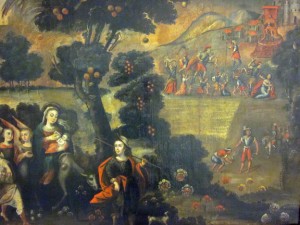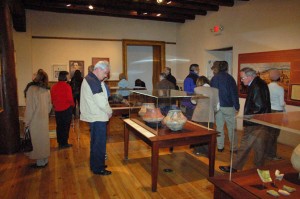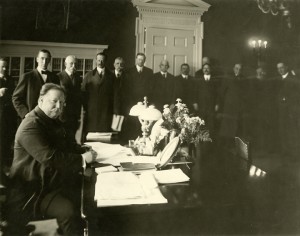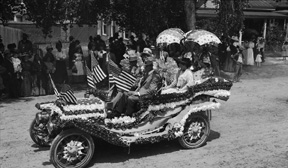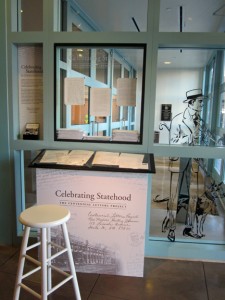 New Mexicans have continued to contribute to the Centennial Letters Project, which now has a home in the window of our front lobby. When you visit, you can read letters that others have contributed and pick up some postcards to leave at your school, library or business to prompt more writers.
New Mexicans have continued to contribute to the Centennial Letters Project, which now has a home in the window of our front lobby. When you visit, you can read letters that others have contributed and pick up some postcards to leave at your school, library or business to prompt more writers.
We like sharing bits and pieces of the letters with you on this blog, so here are a few of our more recent writers.
Sharon in Santa Fe told us about some of the great outdoor experiences she and her husband have had …
…We moved into an adobe house without electricity above Cochiti Pueblo in 1965. sadly, that area with historic Civilian Conservation Corps-built adobes and magnificent views over the Caja del Rio was burned and flooded in New Mexico’s largest wildfire last summer. We have lived in several small villages and had some exciting adventures. I have cooked on wood stoves, ironed with flat irons, pumped water, backpacked extensively in the Pecos Wilderness, raised three children, taught remedial reading, and met many fascinating people of various backgrounds. My husband Mike had an interesting career with the Forest Service, almost entirely on the Santa Fe National Forest. He fought over 200 wildfires in ten states, managed the recreation lands, marked timber sales, and his favorite, designed and built trails. He retired early and started his own business, Pecos Baldy Enterprises. He has designed and built many trails in Northern New Mexico and southern Colorado. …
We have always loved hiking. Mike designed and built the Dale Ball Trail System in the foothills. I hope it is still being used. Maybe our children will have scattered our ashes by our favorite part of the trail. …
Paul in Rio Rancho recalled some of the good times of his childhood in Hurley, New Mexico …..
… I grew up in Hurley, New Mexico, which is a copper-mining town about 15 miles southeast of Silver City. My father was William Earl Morton, and he worked for Kennecott Copper Corporation in Hurley as a refinery tapper for some 28 years. …
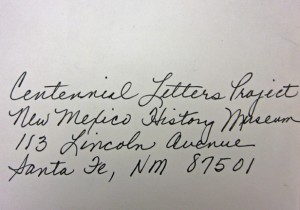 Growing up in Hurley was a bit “different.” It was a small town, and still is, of about 3 to 5 thousand people. What made it different growing up was that Hurley was a “company town”—totally owned and operated by Kennecott Copper Corporation, and surrounded by a barbed wire fence no less. There was a 500 ft. smokestack as part of the refinery, which became quite a local landmark. I can still hear the company whistles signaling start of shift, lunchtime, quitting time, etc. …
Growing up in Hurley was a bit “different.” It was a small town, and still is, of about 3 to 5 thousand people. What made it different growing up was that Hurley was a “company town”—totally owned and operated by Kennecott Copper Corporation, and surrounded by a barbed wire fence no less. There was a 500 ft. smokestack as part of the refinery, which became quite a local landmark. I can still hear the company whistles signaling start of shift, lunchtime, quitting time, etc. …
I can still remember playing stick ball and steal-the-bacon on the streets close to my home. It was a good town for kids, quiet with a very low crime rate. There was a swimming pool, tennis courts, clubhouse with a small bowling alley and library. The town was clean and well maintained. Being a company town, many of the houses looked the same with only a few different styles and sizes available. …
On December 1, 1055, the entire town of Hurley was sold to a developer (John W. Galbreath) and the houses sold to either the occupants or realtors seeking rental homes. My parents eventually owned their own home at 212 Aztec Street in Hurley. …
Michael in Los Alamos brought us back to the earth — and the economy — of today ….
…Last May I graduated with a Master’s degree from UNM. I have been looking for a real job ever since. Work has been hard to find, and I was forced to move back to my parents’ home. It used to be an anomaly for someone in their thirties like myself to move back into the home of their youth. Now it seems more common. Unfortunately the best work I have found of late is as an extra in a movie that is being filmed here. It is kind of funny, spending so much time and energy in getting a graduate degree only to get a job whose only qualification is the ability to grow lots of facial hair (the movie’s a Western).
Lately I have been looking for work out of state. I would love to be able to stay here, but I am not sure I can afford to do so. If I leave I will probably be drawn back again. There is so much I would miss, but I would likely come back just to smell the ponderosa trees after a summer rain. …
I hope that we have done enough to ensure that they (the ponderosas) and the rest of the amazing landscape of New Mexico remain to be enjoyed. I also hope that you will do what it takes to ensure that it remains for those that come one hundred years after you.
Smile, breath deeply, be happy, and take care of yourself.
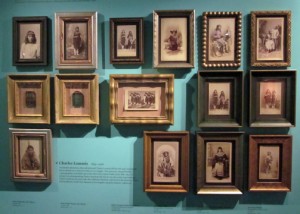 Native American Portraits: Points of Inquiry, the new exhibition in the New Mexico History Museum’s Mezzanine Gallery, features more than 50 exquisite, original prints taken from the mid-1800s to 1035. What makes them even more arresting are the more than 50 frames surrounding each photo.
Native American Portraits: Points of Inquiry, the new exhibition in the New Mexico History Museum’s Mezzanine Gallery, features more than 50 exquisite, original prints taken from the mid-1800s to 1035. What makes them even more arresting are the more than 50 frames surrounding each photo.


